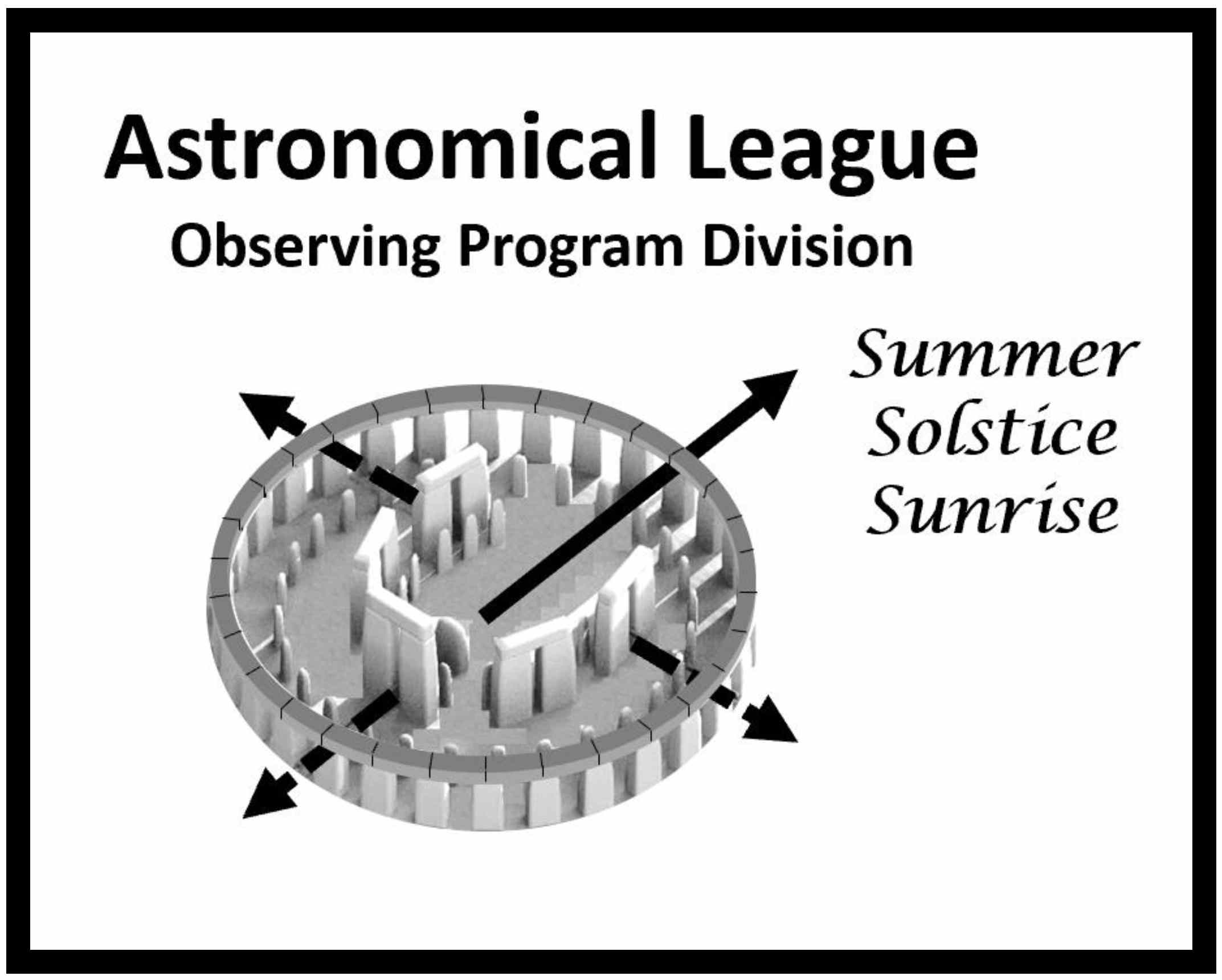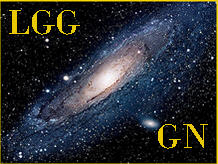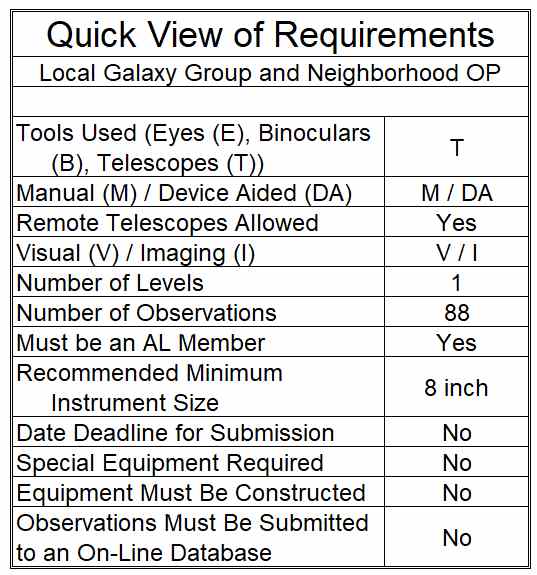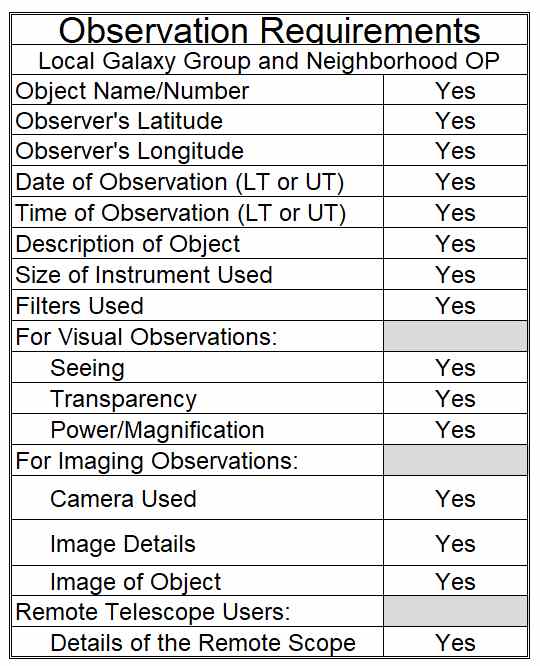Local Galaxy Group and Neighborhood Observing Program Coordinator:Mark Simonson |
  |
Introduction
| Welcome to the Astronomical League’s Local Galaxy Group and Neighborhood Observing Program.
The Local Group is dominated by the big three spiral galaxies: Andromeda, Milky Way and M33. There are dwarf galaxies that orbit these major galaxies and exist in their shadow. Most of the dim lesser galaxies are not as visible as their brighter companions. Investigations from various radio telescopes across the world have discovered new companion galaxies around the Milky Way. The Local Group is gravitationally bound in a cloud surrounding the more massive galaxies. When we go deeper in magnitude or peer farther into the universe, the low surface brightness galaxies are more apparent. Professional astronomers continue to discover diffused clouds of stars associated with the Local Group. Associated galaxy complexes in the Local Group and Galactic Neighborhood are observable in modest-sized telescopes. Therefore, amateur astronomers have access to these striking and scientifically significant objects. Many of these brighter galaxies in the galactic neighborhood are in popular catalogs, such as Messier and Caldwell. Most of the galaxies, clusters and clouds in this Observing Program are visually accessible with a 10 – 12/5″ telescope, although there are individual objects in some of the groups that are beyond almost all amateur observers. Although this Observing Program accommodates CCD cameras and imagers, you don’t need a CCD camera to complete this program. You will be able to see at least some galaxies in all of the groups. |
 |
There are several rewards for undertaking this program, no matter which method you choose. Subtle visual detection will reward you with the thrilling experience of viewing extremely distant objects at the very edge of visibility. In a CCD image, this same cluster may be a very beautiful cloud of galaxies and their dim clouds of globular clusters.
Learning to identify star fields is important even with a computer-driven telescope. An observer must match the galaxies with their map coordinates. Many of the clusters in this Observing Program’s catalog are dim and difficult objects to find, requiring the observer to starhop and use averted vision.
To obtain your certificate and pin for this program, we strongly encourage you to purchase The Local Galaxy Group and Galactic Neighborhood Visual and CCD Observing Guide from the AL Bookstore specifically written to support this Observing Program. This guide is for amateur astronomers wanting to observe and/or image the local group galaxies and groups within approximately 12 million light years. This guide contains information about the requirements of this program as well as star maps to aid you in locating the required galaxies. This guide includes a brief overview of some of the most popular catalogs and atlases to assist you with their use and content. You will also find a variety of helpful observing hints, techniques, coordinates, data and technical information about the galaxies of the local group.
Requirements and Rules
This certification is available to members of the Astronomical League, either through their local astronomical society or as members at large. If you are not a member and would like to become one, check with your local astronomical society, search for a local society on the Astronomical League Website, or join as a Member-at-Large.
You may choose from the lists of objects in the tables in the Observing Manual. You are required to observe any 88 objects to receive the certificate and pin.
Objects included in the Observing Program are broken down into these groups:
| Group | Number |
| Local Group – Visual Galaxies | 24 |
| Local Group – CCD Challenge Galaxies | 9 |
| Milky Way and Extragalactic Globular Clusters | 8 |
| Fornax Galaxy Globular Clusters | 6 |
| Brightest Objects in the Large Magellanic Cloud | 39 |
| Brightest Objects in the Small Magellanic Cloud | 14 |
| Andromeda Galaxy Globular Clusters | 4 |
| Brightest Objects in the M33 Galaxy | 7 |
| Sculptor South Polar Galaxy Group | 7 |
| M81 North Polar Galaxy Group | 15 |
| Maffei 1 and Maffei 3 Galaxy Group | 8 |
| M83 Galaxy Group | 7 |
| M64 and M94 Galaxy Group | 9 |
| M101 Galaxy Group | 6 |
| M106 Galaxy Group | 10 |
| M51 Galaxy Group | 8 |
| M66 Galaxy Group | 4 |
| Canes II Galaxy Group | 4 |
| NGC 2841 | 1 |
| Brightest Objects in the Northern M109 Galaxy Group | 32 |
| Brightest Objects in the Southern M109 Galaxy Group | 27 |
| Virgo Supercluster Galaxies | 51 |
| Fornax Galaxy Cluster | 52 |
| TOTAL REQUIRED | 88 |
| Southern Sky LGG Challenge | |
| Group | Number |
| Small Magellanic Cloud Nebulae and Open Clusters | 13 |
| Small Magellanic Cloud Globular Clusters | 7 |
| Large Magellanic Cloud Nebulae and Open Clusters | 39 |
| Large Magellanic Cloud Globular Clusters | 13 |
| TOTAL REQUIRED | 45 |
| There are two categories of search methods for this program, Manual and Device-Aided. To be considered for the Manual certificate, ALL of the objects must be observed manually. A space is provided on the Submittal Form to indicate your search method. Remote telescopes are permitted in this Observing Program.
Manual infers that the observer hand-guides the telescope to the object. The observer uses his/her eye to see through the telescope to navigate to the object. Device-Aided infers the observer uses manual or digital setting circles, computer devices or other automatic aids in locating the object. There are also two types of observing techniques, Imaging infers that the object is observed with the eye through the optics of the telescope. Imaging infers observations are obtained using astrophotography and/or CCD techniques. From all the objects listed in the Local Group & Galactic Neighborhood Guide, you must observe at least 88. Record your observations on the form provided in the guide or another log as long as all required data is included. |
 |
Write object descriptions that will include at a minimum:
- Date and Time (local time or Universal Time)
- Site (name site and include latitude, longitude and elevation)
- Seeing (describe on a scale; indicate which scale you are using)
- Transparency (give naked eye limiting magnitude or specify an alternate scale)
- Averted vision level if applicable (rate according to an averted vision scale)
- Instrument (include information on telescope, eyepieces, CCD cameras or other instrumentation)
- Description, in your own words, of the group and individual galaxies as appropriate (in many cases you may only see a very faint smudge).
Submitting for Certification
| Complete an index by putting the page number of your descriptions next to the groups and clusters on the list. The check-off and date columns are for your own use.
To receive your Local Galaxy Group and Neighborhood Certificate and Pin, complete the submission form (found in the Guide, or equivalent), along with a copy of your observations, to the Local Galaxy Group and Neighborhood Observing Program Coordinator. Be sure to include: your name, mailing address, email address, phone number, society affiliation, and to whom the certification should be sent. |
 |
Local Galaxy Group and Neighborhood Observing Program Coordinator:
Mark Simonson
1519 Ridge Drive
Camano Island, WA 98282
(360) 387-9548
E-mail: marknilse@yahoo.com
Upon verification of your submission and of your active membership in the Astronomical League, your recognition (certificate, pin, etc.) will be sent to you or to the awards coordinator for your society, as you specified. Your name will also appear in an upcoming issue of the Reflector magazine and in the Astronomical League’s online database. Congratulations. Good luck with your next observing challenge.



